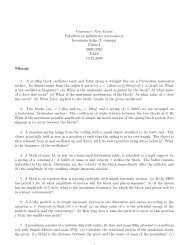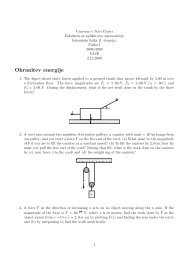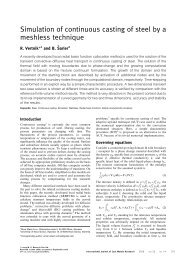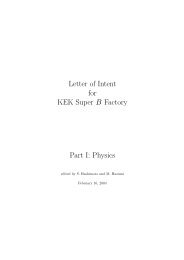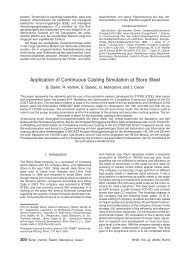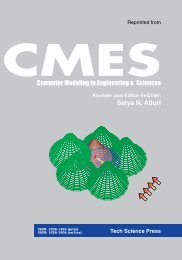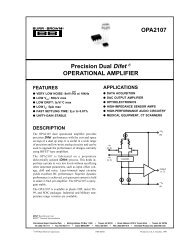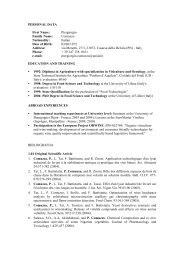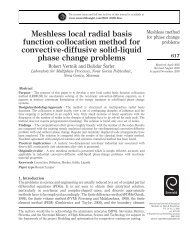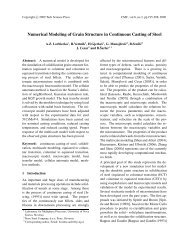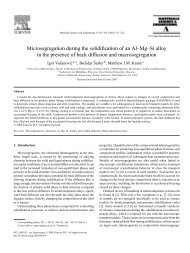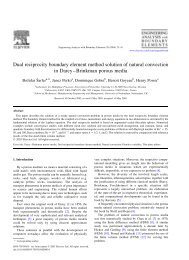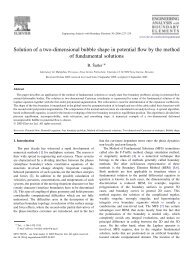Letter of Intent for KEK Super B Factory Part I: Physics
Letter of Intent for KEK Super B Factory Part I: Physics
Letter of Intent for KEK Super B Factory Part I: Physics
You also want an ePaper? Increase the reach of your titles
YUMPU automatically turns print PDFs into web optimized ePapers that Google loves.
By measuring the branching ratios <strong>of</strong> the three decay modes and the time dependent asymmetry<br />
<strong>of</strong> π + π − , one can determine the absolute values |A0| and |A2| and their relative phase difference<br />
arg(A0A ∗ 2 ), through a simple geometric reconstruction. Then, the angle φ2 can be determined<br />
up to a four-fold ambiguity.<br />
Another solution is to consider the isospin relations among B → ρπ decays [20]. There are<br />
three possible decay chains B 0 → {ρ + π − , ρ 0 π 0 , ρ − π + } → π + π − π 0 . Together with their CP -<br />
conjugate amplitudes, there exist six different amplitudes, each <strong>of</strong> which has contributions from<br />
both tree and penguin diagrams. By combining the time-dependent asymmetry <strong>of</strong> this process<br />
in the Dalitz plot one may extract the pure tree amplitude, and thus the angle φ2.<br />
If there is non-negligible contribution from the electroweak penguin diagram, the isospin relations<br />
are violated, since up and down quarks have different charges [21]. However, such a contribution<br />
is suppressed compared to the gluon penguin by a factor α [weak(m 2 t /m 2 Z )]/αs ln(m 2 t /m 2 c)] ∼<br />
0.1 [22]. At <strong>Super</strong>-<strong>KEK</strong>B, the actual size <strong>of</strong> the electroweak penguin amplitude can be estimated<br />
from the analysis <strong>of</strong> Kπ decays [22–26].<br />
The prospects <strong>of</strong> measuring the angle φ2 at <strong>Super</strong>-<strong>KEK</strong>B using these methods are discussed<br />
in Section 4.7.<br />
2.5 Theoretical Methods<br />
In order to extract fundamental parameters, such as the quark masses and CKM matrix elements,<br />
from B decay experiments, one needs model independent calculations <strong>of</strong> the decay amplitudes.<br />
However, since B meson decays accompany complicated QCD interactions, which are highly<br />
non-perturbative in general, the theoretical calculation <strong>of</strong> physical amplitudes is a non-trivial<br />
task.<br />
2.5.1 Heavy Quark Symmetry<br />
One useful theoretical method with which one can avoid the hadronic uncertainty is to use<br />
symmetries. Using isospin or SU(3) flavor symmetries, different decay amplitudes can be related<br />
to each other. This approach is widely used in B decay analyses, e.g. the isospin analysis <strong>of</strong> ππ<br />
decays to extract sin 2φ2 discussed in Section 2.4.2.<br />
Another symmetry which is especially important in B physics is the heavy quark symmetry<br />
[27, 28]. In the limit <strong>of</strong> an infinitely heavy quark mass, the heavy quark behaves as a static<br />
color source and the QCD interaction cannot distinguish different flavors, i.e. charm or bottom.<br />
Consequently the decay amplitudes (or <strong>for</strong>m factors) <strong>of</strong> b and c hadrons are related to each<br />
other (heavy quark flavor symmetry). Moreover, since the spin-dependent interaction decouples<br />
in the infinitely heavy quark mass limit, some <strong>for</strong>m factors become redundant (heavy quark spin<br />
symmetry). The most famous example is the heavy-to-heavy semi-leptonic decay B → D (∗) ℓνℓ<br />
<strong>for</strong>m factors. In general there are 6 independent <strong>for</strong>m factors <strong>for</strong> these exclusive decay modes,<br />
but in the heavy quark limit they reduce to one: the Isgur-Wise function, and its normalization<br />
in the zero-recoil limit is determined.<br />
A more general <strong>for</strong>malism has also been developed in the language <strong>of</strong> effective field theory,<br />
i.e. Heavy Quark Effective Theory (HQET) [29–31]. It provides a systematic expansion in terms<br />
<strong>of</strong> ΛQCD/mQ.<br />
37



